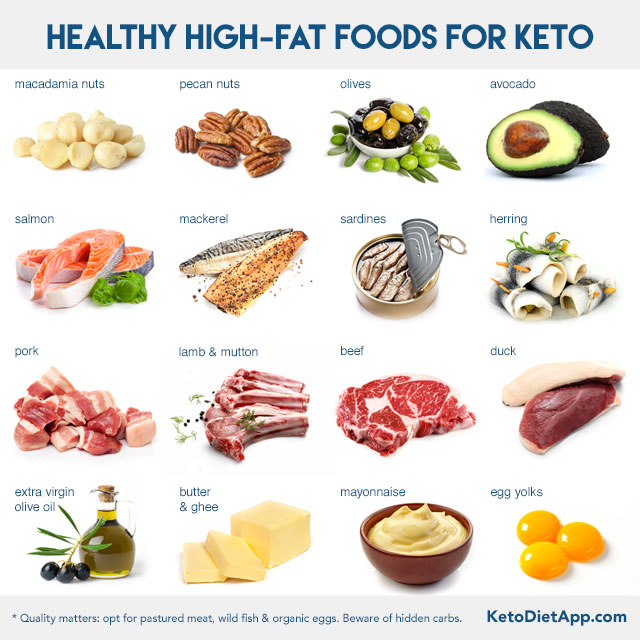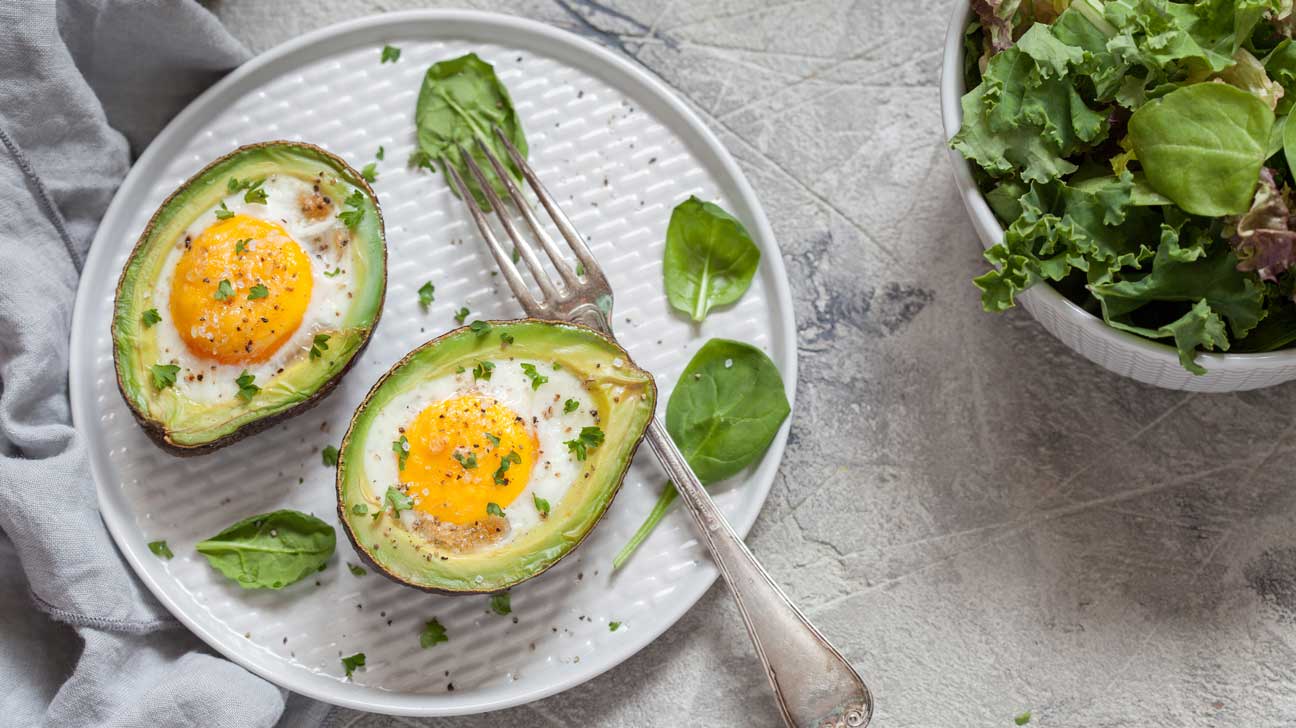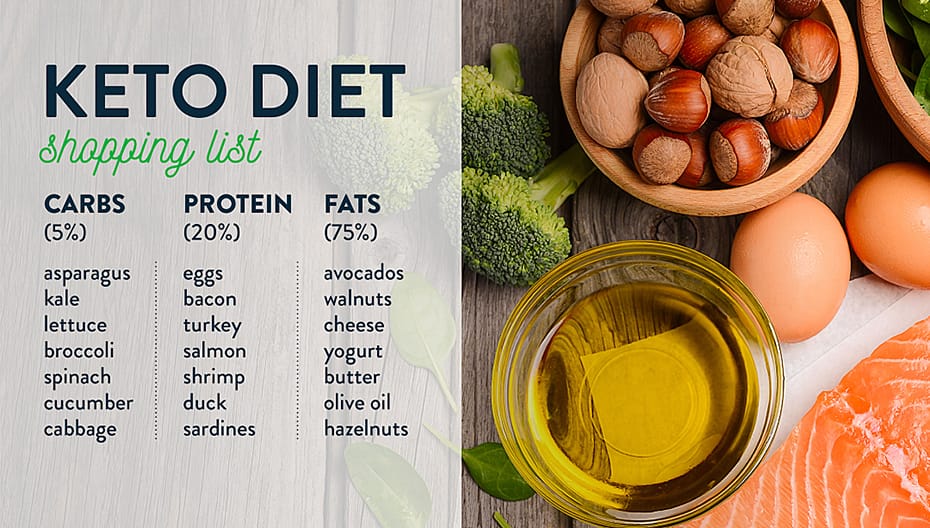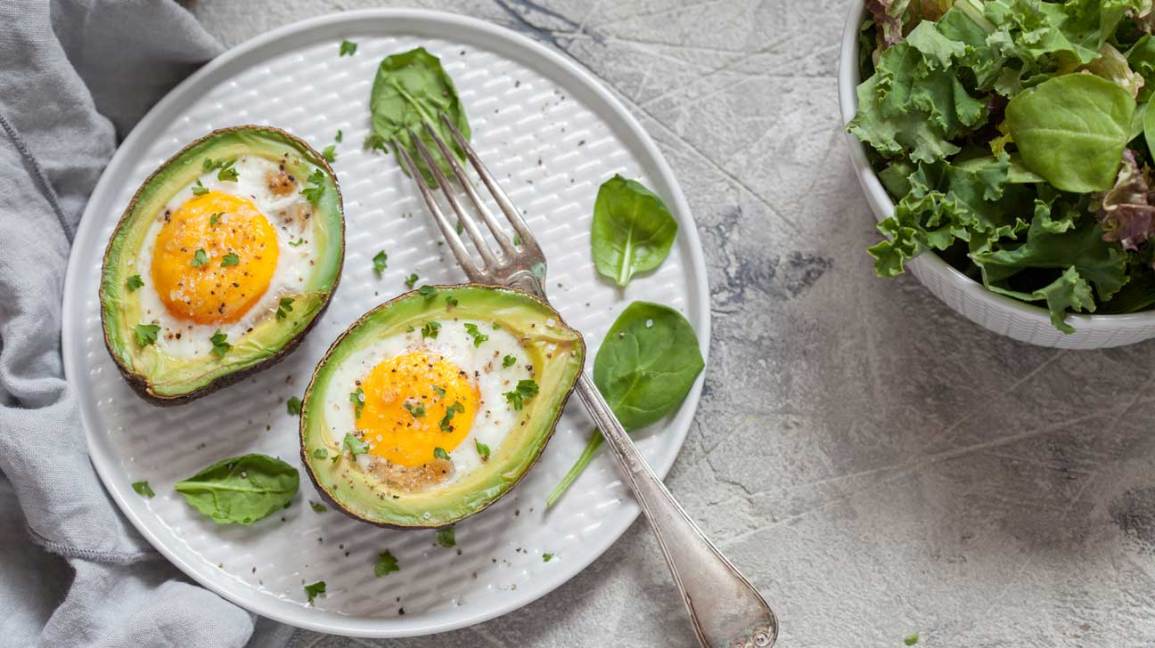What Healthy Fats Should I Eat on Keto? Healthy fats to eat on keto include avocados, olive oil, coconut oil, nuts, seeds, and fatty fish. These fats support ketosis and provide essential nutrients.
The ketogenic diet focuses on high-fat, low-carb foods to promote ketosis. Healthy fats are crucial for energy and overall health. Avocados are rich in monounsaturated fats and fiber. Olive oil offers heart-healthy fats and antioxidants. Coconut oil provides medium-chain triglycerides (MCTs) that boost energy.
Nuts and seeds are excellent sources of omega-3 fatty acids and protein. Fatty fish like salmon and mackerel supply essential omega-3s and support brain health. Including these fats ensures a balanced keto diet, aiding weight loss and maintaining metabolic health. Choose quality fats for optimal results on your keto journey.

Credit: ketodietapp.com
Introduction To Keto And Healthy Fats
What Healthy Fats Should I Eat on Keto? The keto diet is a low-carb, high-fat diet. It aims to put your body in ketosis, burning fat for fuel. Healthy fats are key to success on keto. They provide energy and keep you full.
The Role Of Fats In Keto
Fats are the primary energy source on a keto diet. They help you stay in ketosis. Your body uses fats to create ketones. These ketones fuel your brain and body.
Why Quality Matters
Not all fats are equal. Quality fats benefit your health. They support heart health and reduce inflammation. Choose fats from natural sources.
| Type of Fat | Source | Benefits |
|---|---|---|
| Saturated Fats | Butter, Coconut Oil | Boosts energy and brain function |
| Monounsaturated Fats | Avocados, Olive Oil | Supports heart health |
| Polyunsaturated Fats | Fatty Fish, Walnuts | Reduces inflammation |
- Saturated Fats: Found in butter and coconut oil. These fats boost energy and brain function.
- Monounsaturated Fats: Found in avocados and olive oil. These fats support heart health.
- Polyunsaturated Fats: Found in fatty fish and walnuts. These fats reduce inflammation.
Avocado: A Superfood For Keto
What Healthy Fats Should I Eat on Keto? Avocados are a staple in the keto diet. They are packed with healthy fats and nutrients. This superfood helps you stay full and energized. Learn why avocados are perfect for keto below.
Nutritional Benefits
Avocados are rich in healthy fats. They provide monounsaturated fats, which are heart-healthy. They also contain fiber, which aids digestion.
Here is a table showing the key nutrients in one avocado:
| Nutrient | Amount |
|---|---|
| Calories | 234 |
| Fat | 21 grams |
| Fiber | 10 grams |
| Vitamin K | 26% of daily value |
| Folate | 20% of daily value |
Avocados are also high in potassium. This helps maintain electrolyte balance. They are low in carbs, making them ideal for keto.
Ways To Incorporate Into Your Diet
There are many ways to enjoy avocados on a keto diet. Here are some ideas:
- Guacamole: Mash avocados with lime, salt, and spices.
- Salads: Add sliced avocado to your favorite salad.
- Smoothies: Blend avocado with keto-friendly fruits and veggies.
- Avocado toast: Use keto bread and top with mashed avocado.
- Baked dishes: Stuff avocados with eggs or cheese and bake.
These methods are simple and delicious. Avocados can make any meal more nutritious. Try adding them to your daily diet for the best results.
Coconut Oil: Medium-chain Triglycerides
The ketogenic diet emphasizes consuming healthy fats. One such fat is coconut oil. This oil contains medium-chain triglycerides (MCTs), which are excellent for ketosis.
Benefits For Ketosis
What Healthy Fats Should I Eat on Keto? Coconut oil is rich in MCTs. These fats are easily digestible. They quickly convert into ketones, fueling your brain and body. This helps maintain a state of ketosis.
Another benefit is appetite control. MCTs help you feel full longer. This can reduce snacking, aiding in weight loss. Coconut oil also supports heart health. It increases good cholesterol and lowers bad cholesterol.
How To Use In Cooking
What Healthy Fats Should I Eat on Keto? Using coconut oil in your kitchen is simple. It has a high smoke point. This makes it perfect for frying and sautéing. You can also use it in baking. Replace butter with coconut oil in recipes for a keto-friendly option.
You can add coconut oil to smoothies. Blend it with your favorite keto ingredients. Use it in your coffee to make a bulletproof coffee. Just mix a tablespoon of coconut oil with your coffee for an energy boost.
| Cooking Method | How to Use Coconut Oil |
|---|---|
| Frying | Use instead of vegetable oil |
| Sautéing | Perfect for vegetables and meats |
| Baking | Replace butter in recipes |
| Smoothies | Add a tablespoon for extra energy |
| Coffee | Blend with coffee for a keto drink |

Credit: www.healthline.com
Olive Oil: Heart-healthy Choice
Olive oil is a staple in the keto diet. It is rich in healthy fats and antioxidants. This oil supports heart health and adds flavor to many dishes.
Types Of Olive Oil
There are different types of olive oil. Each has unique benefits and uses:
| Type | Flavor | Best Use |
|---|---|---|
| Extra Virgin Olive Oil | Rich, fruity, and robust | Salads, dressings, dipping |
| Virgin Olive Oil | Mild and less intense | Cooking and sautéing |
| Light Olive Oil | Subtle and neutral | Baking and frying |
Salads And Beyond
Olive oil isn’t just for salads. You can use it in many ways:
- Drizzle over vegetables: Adds a delicious touch.
- Marinate meats: Enhances flavor and tenderness.
- Bake with it: Keeps baked goods moist.
These tips help you enjoy olive oil in your keto diet. Choose the right type for your needs.
Nuts And Seeds: Nutrient-dense Snacks
What Healthy Fats Should I Eat on Keto? Nuts and seeds are great for a keto diet. They are packed with healthy fats, proteins, and fiber. These snacks can keep you full and energized throughout the day. Let’s explore the best picks for keto and learn how to balance omega-3 and omega-6 fats.
Best Picks For Keto
The following nuts and seeds are ideal for a keto diet:
- Almonds: High in vitamin E and magnesium.
- Walnuts: Rich in omega-3 fatty acids.
- Pecans: Low in carbs and high in antioxidants.
- Chia Seeds: Packed with fiber and omega-3 fats.
- Flaxseeds: Excellent source of omega-3 fatty acids.
Balancing Omega-3 And Omega-6 Fats
Balancing omega-3 and omega-6 fats is crucial. Omega-3 fats reduce inflammation. Omega-6 fats, in excess, can cause inflammation.
| Nut/Seed | Omega-3 Content | Omega-6 Content |
|---|---|---|
| Walnuts | 2.5 g | 10.8 g |
| Chia Seeds | 17.5 g | 5.8 g |
| Flaxseeds | 22.8 g | 5.9 g |
Include a mix of these nuts and seeds in your diet. This ensures you get a balanced amount of omega-3 and omega-6 fats. Aim for more omega-3 fats for better health benefits.

Credit: www.nutritionnews.abbott
Fatty Fish: Omega-3 Powerhouses
What Healthy Fats Should I Eat on Keto? Fatty fish are packed with omega-3 fatty acids, which are essential for a healthy keto diet. These fish not only support heart health but also help reduce inflammation and improve brain function. Including fatty fish in your diet can be a game-changer for your overall wellness.
Choosing The Right Fish
Not all fish are created equal. Here are some of the best options:
- Salmon – Rich in omega-3 and vitamin D.
- Mackerel – High in healthy fats and protein.
- Sardines – Affordable and nutrient-dense.
- Anchovies – Small but packed with omega-3s.
- Herring – Great source of both omega-3 and vitamin B12.
Creative Ways To Add To Your Diet
Incorporating fatty fish into your meals can be delicious and easy. Here are some ideas:
- Grilled Salmon: Season with lemon and herbs for a quick dinner.
- Mackerel Salad: Mix with avocado and greens for a tasty lunch.
- Sardine Spread: Blend with cream cheese and serve with keto crackers.
- Anchovy Pizza: Top your keto pizza crust with anchovies and olives.
- Herring Snacks: Enjoy pickled herring as a quick, protein-packed snack.
Adding fatty fish to your diet can be both nutritious and enjoyable. These omega-3 powerhouses offer numerous health benefits and can be prepared in various delicious ways.
Butter And Ghee: Saturated Fat Sources
In a ketogenic diet, consuming the right fats is essential. Two important sources of saturated fat are butter and ghee. These fats not only enhance flavor but also provide vital nutrients. Let’s explore their benefits and uses in your keto lifestyle.
Clarifying Ghee And Butter
Butter is made by churning cream until the fat separates from the liquid. It’s rich in saturated fats, vitamins, and minerals. Butter is also a good source of conjugated linoleic acid (CLA), which may aid fat loss.
Ghee is a type of clarified butter. It is made by heating butter to remove water and milk solids. This process enhances its flavor and shelf life. Ghee is rich in medium-chain triglycerides (MCTs), which support energy levels and metabolism.
| Nutrient | Butter | Ghee |
|---|---|---|
| Calories per tablespoon | 102 | 112 |
| Saturated fat | 7 grams | 8 grams |
| Vitamins | A, E, K2 | A, E |
Culinary Uses
Butter is versatile in the kitchen. Use it for baking, sautéing, and as a spread. It adds a rich, creamy texture to dishes.
Ghee has a high smoke point, making it ideal for high-heat cooking. It’s perfect for frying, roasting, and even in bulletproof coffee. Ghee imparts a nutty flavor to food, enhancing taste.
Both butter and ghee are valuable additions to your keto diet. They provide essential fats and nutrients while enhancing the flavor of your meals.
Eggs: A Complete Protein
Eggs are a perfect food for the keto diet. They are rich in healthy fats and protein. Eggs also contain essential vitamins and minerals.
Nutritional Profile
Eggs are packed with nutrients that benefit your body. Here is a breakdown:
| Nutrient | Amount per Egg |
|---|---|
| Protein | 6 grams |
| Fat | 5 grams |
| Vitamin A | 5% of daily value |
| Vitamin D | 6% of daily value |
| Choline | 23% of daily value |
Versatile Ways To Prepare
Eggs can be prepared in many delicious ways. Here are some ideas:
- Boiled: Hard or soft-boiled eggs are easy to make.
- Scrambled: Add cheese and veggies for extra flavor.
- Omelette: Fill with meats, cheeses, and vegetables.
- Fried: Use healthy oils like olive or coconut oil.
- Poached: Perfect for a light, healthy meal.
Experiment with different recipes to keep your meals exciting. Eggs are a versatile and nutritious choice for your keto diet.
Cheese: Flavorful And Fatty
What Healthy Fats Should I Eat on Keto? Cheese is a staple for many on a keto diet. It is not only flavorful but also rich in healthy fats. Including cheese in your keto meal plan can add variety and taste while keeping you within your carb limits. Let’s delve into the types of cheese suitable for keto and how to pair them with other foods.
Types Suitable For Keto
There are many types of cheese that fit well within a keto diet. Below is a table listing some popular keto-friendly cheeses:
| Cheese Type | Carbs (per 100g) | Fat (per 100g) |
|---|---|---|
| Cheddar | 1.3g | 33g |
| Brie | 0.5g | 28g |
| Gouda | 2.2g | 27g |
| Blue Cheese | 2.3g | 29g |
| Parmesan | 3.2g | 29g |
Pairing With Other Foods
Cheese can be paired with a variety of keto-friendly foods to create delicious meals and snacks. Here are some ideas:
- Cheddar: Pair with sliced avocado for a creamy snack.
- Brie: Enjoy with a handful of walnuts or almonds.
- Gouda: Melt over steamed broccoli or cauliflower.
- Blue Cheese: Crumble over a fresh salad with olive oil.
- Parmesan: Grate over zucchini noodles or add to a keto soup.
These combinations not only enhance the taste but also add to your daily fat intake, essential for ketosis.
Conclusion: Balancing Your Keto Fat Intake
Finding the right balance of healthy fats on a keto diet is key. It ensures you get the energy you need without harming your health. You need to listen to your body and adjust as needed.
Listening To Your Body
Your body will tell you what it needs. Pay attention to how you feel after eating different fats. This can help you find the best sources for you.
- Feel energized after eating avocados? Add them to your diet.
- Get stomach pain from too much cheese? Cut back.
- Enjoy nuts and seeds? Keep them as a snack option.
Adjusting For Optimal Health
Keep an eye on your overall health. This means checking in with your doctor and getting regular blood tests. Adjust your fat intake based on these results.
Here are some tips for adjusting your fat intake:
- Increase Omega-3s: Eat more fish like salmon and mackerel.
- Limit Saturated Fats: Use olive oil instead of butter.
- Watch Your Portions: Even healthy fats can add up in calories.
| Fat Type | Source | Recommended |
|---|---|---|
| Monounsaturated | Avocado, Olive Oil | Yes |
| Polyunsaturated | Fish, Nuts | Yes |
| Saturated | Butter, Cheese | Limit |
Remember, balance is key. Enjoy a variety of healthy fats to support your keto journey.
Frequently Asked Questions
What Food Has Fat But No Carbs?
Foods with fat but no carbs include avocados, olive oil, and fatty fish like salmon. Cheese and butter also fit this category. These foods are rich in healthy fats and perfect for low-carb diets.
What Are Bad Fats To Avoid On Keto?
Avoid trans fats, hydrogenated oils, and refined vegetable oils like soybean, corn, and canola. These fats are unhealthy on keto.
How To Increase Fat Intake On Keto?
Increase fat intake on keto by consuming avocados, nuts, seeds, olive oil, and fatty fish. Add butter and cheese to meals.
What Are The Best Fats For A Keto Diet?
The best fats for a keto diet include avocados, olive oil, coconut oil, butter, ghee, and fatty fish. These fats are healthy and support ketosis. Avoid trans fats and highly processed oils for optimal results.
Conclusion
Choosing the right fats is crucial for a successful keto diet. Opt for avocados, olive oil, and fatty fish. These healthy fats support your health and keep you in ketosis. Remember, balance and variety are key. Enjoy your keto journey with these nutritious fat sources.




Leave a Reply